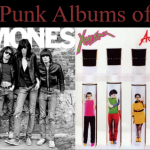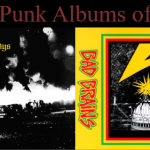Below is the transcript for the video, for those who prefer to read.
1977 has been referred to by music critics as the year punk broke into the mainstream consciousness. In the UK, that was the year that the Sex Pistols and The Clash released their debut albums. Other UK punk and punk adjacent acts such as The Damned, Alternative TV, Elvis Costello, and Sham 69 all released their first recordings between late 1976-77.
In the States, you had the Ramones (who are commonly referred to as the first punk group) who released their debut album in 1976, and they released two more albums in 1977. They were the leaders of the New York punk scene, and along with acts such as Richard Hell & The Voidoids, Patti Smith, The Talking Heads & Blondie, they helped establish CBGB as a legendary venue in the formation of Punk and New Wave.
As with any genre of music, it doesn’t just appear overnight, fully formed. The musical evolution takes place over many decades (sometimes even centuries). The same is certainly true with the evolution of punk rock. We will analyze the developments that led up to the formation of punk rock. We will also look at some of the influential protopunk bands that contributed to the development of the genre.
Origins of the Word Punk
From the 16th century right up to the 18th century, the expression punk carried the idea of being a prostitute. This was the context that William Shakespeare used in a couple of his plays. But the expression of the punk evolved to denote a male hustler, hoodlum, ruffian, or gangster.
The first known use of the expression punk to describe a band or a form of music was on March 22, 1970, Chicago Tribune, when Ed Sanders of the band The Fugs referred to his debut solo album as “punk rock—redneck sentimentality”. Back in November 1970, electronic protopunk duo Suicide was the first group to refer to their music as “punk music” on their promo flyers. In a December 1970 issue of Creem, critic Lester Bang referred to Iggy Pop as “that Stooge punk”.
One of the first critics to coin the expression “punk rock” is David Marsh, who in a May 1971 issue of Creem, described a 60s garage rock band,? and the Mysterians as giving a “landmark exposition of punk rock.”
During the 70s, music critics continued to throw around the label punk, applying it to a diverse group of different types of rock acts (many not generally considered punk by today’s standards) such as The Rolling Stones, Aerosmith, Bruce Springsteen and even the Bay City Rollers.
In late 1975, a popular fanzine called Punk was formed. It featured music that was inspired by MC5, The Stooges & The New York Dolls. The music featured was more indicative of what would become known as “punk rock”.
1963: The Punk Evolution Begins
So, we just focused on the terminology of the word punk. But more importantly, it is now time to focus on the musical evolution of punk. Since punk is a form of rock music, it has the same DNA as rock & roll. So, if you wanted to, you could trace the development of the punk family tree way back. But for argument’s sake, we are going to take the year 1963 as our starting point.
In the 60s, “garage rock” was starting to break through. The raw & minimalistic musical approach of “garage rock” bands was considered an important precursor to punk. One song in particular, which contained the blueprint of the punk sound, was The Kingsmen’s 1963 hit, “Louie, Louie”. Other important “garage rock” tunes that contained the three-chord structure of punk, combined with the raw energy, include “You Really Got Me” by The Kinks and “Wild Thing” by The Troggs.
Along with “garage rock”, “mod rock” was considered an important precursor. Early songs by The Who, such as “I Can’t Explain” and “My Generation,” were very similar to the early punk sound that would later develop.
From there, we have the protopunk bands that were influenced by the “garage rock” and “mod rock” of the 60s. The Velvet Underground is widely considered to be the first “alternative band”. Even though their aesthetic isn’t necessarily punk in itself, they were a tremendous influence on many individuals who were instrumental in the development of punk rock.
In 1969, two extremely influential proto-punk bands emerged from Michigan. The MC5 and The Stooges. The MC5 released their debut album, Kick Out the Jams, which also featured the legendary title track, while The Stooges released their debut self-titled album. Iggy Pop of The Stooges would go on to be widely known as the “godfather of punk”.
The New York Dolls developed a style of music which would be labelled as “glam punk” and David Bowie had many stylistic elements (both musically and in the visual presentation) which would further contribute to the evolution of punk.
Over in the UK, Malcolm McLaren who had a brief stint managing The New York Dolls, was inspired by the CBGB scene. He operated a clothing store called Sex, which was known for its anti-fashion. McLaren help formed The Sex Pistols, which help popularized the anti-fashion that McLaren store was known for.
While this was going on, an associate of McLaren, Bernard Rhodes, was managing the band London SS. London SS ended up disbanding before ever performing in public, but the band ended up merging into two different influential punk bands: The Damned and The Clash. The rest, as they say, is history.
These developments now take us to 1977, the year punk broke. Of course, punk has continued to evolve since then. Who knows, that may just be a subject for a future video.


